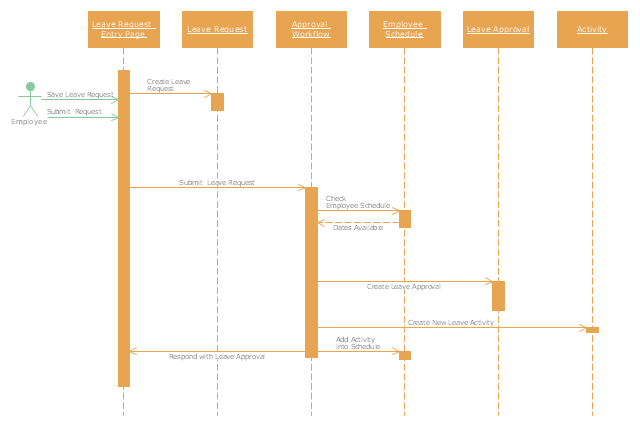"Sequence diagram is the most common kind of interaction diagram, which focuses on the message interchange between a number of lifelines.
Sequence diagram describes an interaction by focusing on the sequence of messages that are exchanged, along with their corresponding occurrence specifications on the lifelines.
The following nodes and edges are typically drawn in a UML sequence diagram: lifeline, execution specification, message, combined fragment, interaction use, state invariant, continuation, destruction occurrence." [uml-diagrams.org/ sequence-diagrams.html]
The template "UML sequence diagram" for the ConceptDraw PRO diagramming and vector drawing software is included in the Rapid UML solution from the Software Development area of ConceptDraw Solution Park.
www.conceptdraw.com/ solution-park/ software-uml
Sequence diagram describes an interaction by focusing on the sequence of messages that are exchanged, along with their corresponding occurrence specifications on the lifelines.
The following nodes and edges are typically drawn in a UML sequence diagram: lifeline, execution specification, message, combined fragment, interaction use, state invariant, continuation, destruction occurrence." [uml-diagrams.org/ sequence-diagrams.html]
The template "UML sequence diagram" for the ConceptDraw PRO diagramming and vector drawing software is included in the Rapid UML solution from the Software Development area of ConceptDraw Solution Park.
www.conceptdraw.com/ solution-park/ software-uml
"A schedule or timetable is a basic time management tool consisting of a list of times at which possible tasks, events, or actions are intended to take place, or a sequence of events in the chronological order in which such things are intended to take place. The process of creating a schedule - deciding how to order these tasks and how to commit resources between the variety of possible tasks - is called scheduling, and a person responsible for making a particular schedule may be called a scheduler. Making and following schedules is a fundamental human activity, and learning to do these things effectively is one of the most basic life skills. There are a wide variety of situations in which schedules are necessary, or at least useful.
Schedules are useful for both short periods, such as a daily or weekly schedule, and for long term planning with respect to periods of several months or years. They are often made using a calendar, where the person making the schedule can note the dates and times at which various events are planned to occur. Schedules that do not set forth specific times for events to occur may instead list an expected order in which events either can or must take place." [Schedule. Wikipedia]
The UML sequence diagram example "Checking process" was created using the ConceptDraw PRO diagramming and vector drawing software extended with the Rapid UML solution from the Software Development area of ConceptDraw Solution Park.
Schedules are useful for both short periods, such as a daily or weekly schedule, and for long term planning with respect to periods of several months or years. They are often made using a calendar, where the person making the schedule can note the dates and times at which various events are planned to occur. Schedules that do not set forth specific times for events to occur may instead list an expected order in which events either can or must take place." [Schedule. Wikipedia]
The UML sequence diagram example "Checking process" was created using the ConceptDraw PRO diagramming and vector drawing software extended with the Rapid UML solution from the Software Development area of ConceptDraw Solution Park.
- ATM UML Diagrams
- UML Sequence Diagram Example. SVG Vectored UML Diagrams ...
- UML Sequence Diagram
- UML Diagrams with ConceptDraw PRO | UML Sequence Diagram ...
- UML Sequence Diagram | Sequence UML for ATM | Diagramming ...
- ATM UML Diagrams | Diagramming Software for designing UML ...
- Bank Sequence Diagram | UML Diagram | UML Use Case Diagram ...
- Design elements - Bank UML sequence diagram | UML Deployment ...
- UML sequence diagram - Help desk | UML Diagram | UML Use ...
- UML Sequence Diagram . Design Elements
- UML sequence diagram - Template | UML Sequence Diagram ...
- Diagramming Software for designing UML Sequence Diagrams ...
- Diagramming Software for designing UML Sequence Diagrams ...
- Best Vector Drawing Application for Mac OS X | UML Sequence ...
- UML Sequence Diagram | UML Sequence Diagram . Design ...
- Bank Sequence Diagram | Sequence UML for ATM | UML Use Case ...
- Sequence UML for ATM | UML Diagram | Rapid UML | Banking ...
- UML Sequence Diagram . Design Elements | UML Use Case ...
- ATM Sequence diagram | Bank Sequence Diagram | UML ...

